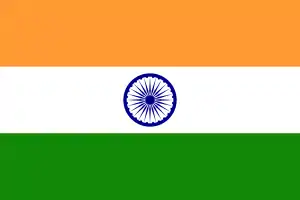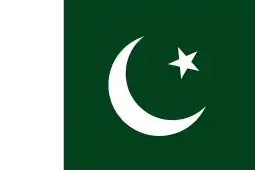Indians in Pakistan
Indians in Pakistan typically refers to Indian nationals working, studying or generally residing in Pakistan as expatriates. It also includes Indian emigrants to Pakistan (post-Partition era), Indian spouses married to Pakistanis, as well as Indians who have become naturalized Pakistani citizens and other people of Indian origin within Pakistan.
| |
|---|---|

 | |
| Total population | |
| c. 2,000,000[1][2] (16,501 Indian citizens)[3] | |
| Regions with significant populations | |
| Predominantly Punjab and Sindh | |
| Languages | |
| Hindi–Urdu, Punjabi, others | |
| Religion | |
| Related ethnic groups | |
| Indian diaspora |
History
There has been a history of immigration occurring between India and Pakistan due to the two countries sharing a common border.[6] Between 1979 and 1981, there were estimated to be roughly 18,302 Indians who were overstaying illegally in Pakistan.[7] According to Pakistani government figures in 1995, there were believed to be thousands of Indian immigrants living in Karachi, Sindh.[8]
In 2005, the Indian government acknowledged that there were 1,348 Indians in Pakistani jails, including civilians, captured fishermen, convicted criminals and prisoners of war.[9] India has alleged that Dawood Ibrahim, a prominent Indian underworld don, resides in the Pakistani city of Karachi, although this claim has been rejected by Pakistan. Former President of Pakistan, Pervez Musharraf, stated that Ibrahim is "held in 'high esteem' by many in [Pakistan]".[10] In 2008, the Indian foreign ministry advised its citizens to avoid travel to Pakistan after a series of mass-suicide bombings in Lahore, Punjab, Pakistan.[11][12] As of 2013, there were 1,184 Indians serving prison sentences in Pakistani jails.[13]
Notable individuals
- Josh Malihabadi – British Indian and later Pakistani poet (d. 1982)
- Kashmir Singh – Indian spy captured while operating in Pakistan (imprisoned 1973–2008)
- Kulbhushan Jadhav – Indian Navy officer captured near the Iran–Pakistan border; alleged to be involved in espionage and terrorism in Balochistan, Pakistan[14][15][16]
- Lakhbir Singh Rode – Indian Sikh member of the Khalistan Zindabad Force, allegedly living in Lahore, Pakistan
- Parminder Singh Saini – Indian national and Sikh Khalistani separatist operating in Canada; sentenced to death in Pakistan (later commuted to 10 years)
- Sarabjit Singh – Indian national convicted for terrorist activity and espionage in Pakistan (d. 2013)[17][18][19]
- Rais Khan – British Indian and later Pakistani musician (d. 2017)
See also
- Partition of British India (Division of India into Hindu-majority India and Muslim-majority Pakistan)
- Muhajir people (Muslims who migrated to Pakistan from India following Partition in 1947)
- Pakistanis in India
- Hindi language in Pakistan
- Bengalis in Pakistan
- Tamils in Pakistan
References
- "India is a top source and destination for world's migrants". Pew Research Center. 3 March 2017. Retrieved 7 March 2017.
- "More Indian migrants in Pakistan than in US: Pew report - Times of India". The Times of India. Retrieved 7 March 2017.
- Gishkori, Zahid (30 July 2015). "Karachi has witnessed 43% decrease in target killing: Nisar". The Express Tribune. Retrieved 3 August 2017.
Interestingly, around 16,501 Indians are also living in Pakistan.
- "Indian community in Pakistan celebrates Diwali". Times of India. 1 November 2013. Retrieved 25 November 2013.
- "What it feels like being a Sikh in Pakistan". India Today.
- Natesan, G.A. (1957). Indian Review, Volume 58. University of California: G.A. Natesan & Co. p. 415.
- India today, Volume 7. University of Virginia: Thomson Living Media India Ltd. 1982. p. 60.
- Tohid, Owais; Mahmud, Arshad (29 November 1995). "Homeless In Karachi". Outlook India. Retrieved 8 July 2012.
- Mahendra, Gaur (2008). Foreign Policy Annual. pp. 536–537. ISBN 978-8178353425.
- "Dawood Ibrahim is held in high esteem in Pakistan: Musharraf". NDTV. 16 November 2011. Retrieved 8 July 2012.
- "Indians told Pakistan 'not safe' for them". Dawn. 27 December 2008. Retrieved 8 July 2012.
- "Avoid Pakistan travel, India tells citizens". 27 December 2008. Retrieved 8 July 2012.
- "1,184 Indians in Pak jails, says MEA". Times of India. 5 May 2013. Retrieved 9 November 2014.
- "The Express Tribune". Watch: Kulbushan Jadhav's confession. Retrieved 6 November 2019.
- "Timeline: How the Kulbhushan Jadhav saga unfolded". Dawn News. Retrieved 6 November 2019.
- "Jadhav admits working for RAW during consular access". The Express Tribune. Retrieved 6 November 2019.
- Web Edition (29 June 2012). "Sarabjit Singh is a terrorist: Surjeet". The News International 2012. Retrieved 2 May 2013.
According to the testament of his fellow spy operatives, Surjeet Singh, confirming that Sarabjit Singh is a terrorist and terrorists are neither released by India nor Pakistan....
- staff (2 May 2013). "Sarabjit Singh, how a terrorist becomes a hero". Voice of Journalist. Retrieved 2 May 2013.
- "Sarabjit Singh: Indian 'spy' dies after Pakistan attack". BBC News. 2 May 2013. Retrieved 2 May 2013.